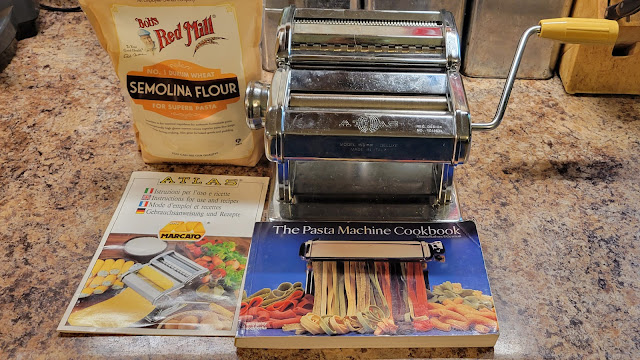At its heart, basic pasta is a simple combination of flour (usually Durum
Semolina) and water in the right proportions. A good noodle dough can also be made with flour and egg,
or a combination of flour, water, egg,
and oil, but these extra ingredients aren’t an absolute necessity for good
noodles. Beyond those basics all sorts of additional flavorings can
be added to fresh noodles, most commonly herbs and spices, and if rolled out
carefully small seeds can be mixed in, although there is a concern with tearing the dough.
While pasta can be made entirely by hand, there are a number
of labor saving options, from the classic Marcato Atlas manual pasta maker, an attachment for a KitchenAid mixer, or a dedicated electric pasta maker. Yard and estate sales are good places to look for these items, often at a sharp discount.
 |
| The author's Marcato Atlas |
Most pasta makers will come with a small recipe book, but
there are many more comprehensive ones available. My personal favorite is an older
copy of The Pasta Machine Cookbook, but there’s also an updated edition. For those who like ravioli, there are manual,
Atlas,
and KitchenAid
options to make those as well. Since I don’t make them very often, I only have
an older variation of the manual ravioli press, though I have considered
getting the Atlas attachment.
Preparation of most types of flat noodles is extremely
straight forward: Mix the ingredients according to the recipe, roll out to the
appropriate thinness, and then cut into the desired shapes. Unless it’s being cooked right away, pasta needs to dry a
bit before being stored; there are a number of racks available on
the market (such as this or this) for that step. While most are made of wood or plastic, metal drying
racks can occasionally be found.
Short term storage (a few days) can be in any container with a tight
fitting lid in the refrigerator; any longer than that and the pasta
should be more thoroughly dried, wrapped tightly in plastic wrap or vacuum
sealed to reduce oxidation, and then frozen. Even then, it should be eaten within a
month or so, as its flavor and texture are likely to change over time.
Once the pasta is made, it’s ready to be cooked: just drop
it in a pot of water boiled with a pinch of salt, which increases the boiling
temperature slightly. If you made the paste with an egg, the suggested minimum cook time is
usually around five minutes to make sure any C. botulinum
spores are killed; pasta made without egg can be cooked for a shorter time
based on desired tenderness.
Once the pasta is done to the desired tenderness, drain the water, top with your preferred sauce -- conventional wisdom states that the thinner the pasta, the lighter the
sauce: gravy for thick egg noodles, a hearty tomato sauce for linguini, and a simple olive oil (or butter) and garlic for angel hair -- serve, and enjoy.
Bon appétit!


No comments:
Post a Comment